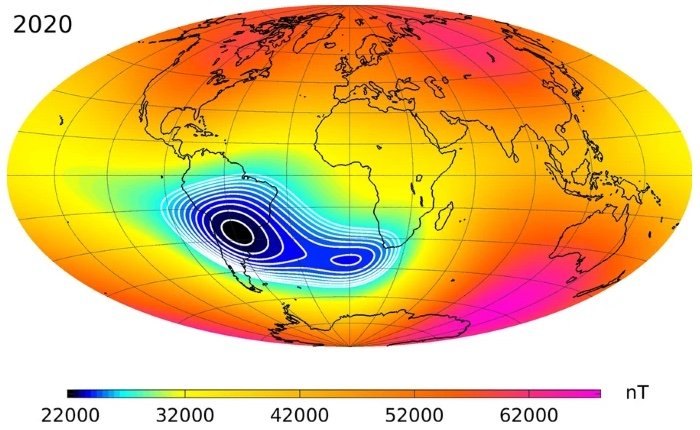An anomalous magnetic region in the South Atlantic Ocean is growing, according to data that appeared in a government report published earlier this year.
The South Atlantic Anomaly is a location in the southern Atlantic where the innermost portions of the natural zone of energetic charged particles encircling Earth, known as the Van Allen radiation belt, makes its closest approach to the planet. The resulting outflow of energized particles produces a higher yield of ionizing radiation detectable by satellites orbiting Earth.
The anomaly is one of the components monitored by several international government agencies that comprise the World Magnetic Model (WMM), a “spherical harmonic model of the Earth’s main magnetic field and its slow temporal change.”The model is produced by the U.S. National Geospatial-Intelligence Agency (NGA) and the U.K. Defence Geographic Centre (DGC), based on information developed by the British Geological Survey (BGS) and the U.S. National Centers for Environmental Information (NCEI), which is responsible for monitoring the largest set of archives containing information on atmospheric, oceanic, coastal, and geophysical data from the surface of the Earth, as well as from below its crust extending down to the planetary core.
A Dynamic Geomagnetic Field
Our planet’s geomagnetic field undergoes constant changes that result from the activity occurring in the Earth’s core, which current models aren’t capable of easily predicting. Because of this, the World Magnetic Model can only offer a good estimate of the Earth’s geomagnetic activity in “snapshots” over time, and must be updated every five years or so.
The latest version of the report, based on data collected in an assessment in December 2021, was released on January 1, 2023, in accordance with specifications outlined by the U.S. Department of Defense.
According to the newest version of the report, comparisons made between data from data that dates back to 2019 with more recent data made available by the European Space Agency (ESA) and its Swarm satellites concluded that the current models are still accurate.
However, the new report also details what scientists have characterized as a “deepening” of the South Atlantic Anomaly (SAA).


A Deepening Anomaly in the South Atlantic
“The SAA is deepening and moving westwards,” the authors state in the January report.
“The area affected,” the authors state, “has increased by about 5% over this time. This contour approximates the region where radiation damage to satellites is most likely to occur.”
According to the report, the SAA continues to have an impact in a variety of ways that range from potential damage to satellites from excessive radiation, to obstructing radio propagation. Although the report’s authors also note that the SAA is believed to impact polar regions, they add that “the impacts there are less dependent on field intensity.”
“NCEI continues to monitor the situation closely,” the report states.
“Regardless of these minor concerns, all data gathered for the annual report indicates that the WMM2020 is still operating well below the margin of error stipulated by the U.S. Department of Defense,” the report’s authors state.
“The model can thus continue to be relied on by all technology that implements it,” they add.
The entire report can be read online at the website of the U.S. National Centers for Environmental Information.
Micah Hanks is the Editor-in-Chief and Co-Founder of The Debrief. He can be reached by email at micah@thedebrief.org. Follow his work at micahhanks.com and on Twitter: @MicahHanks.

